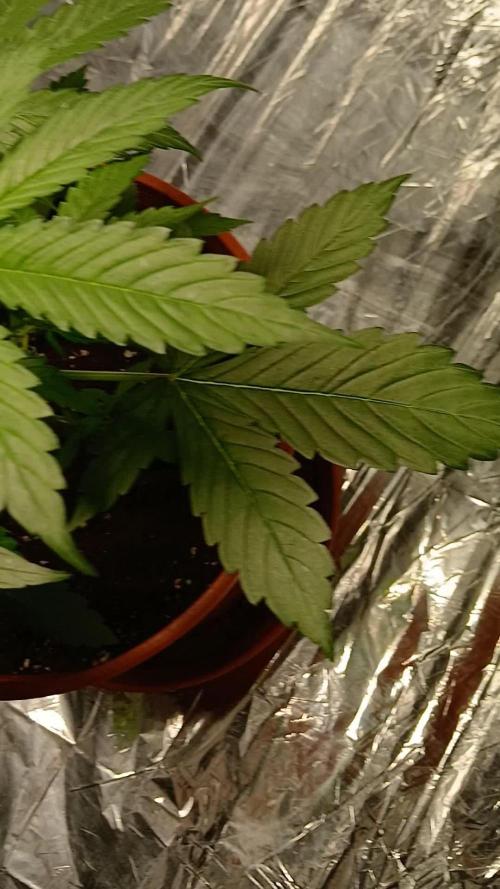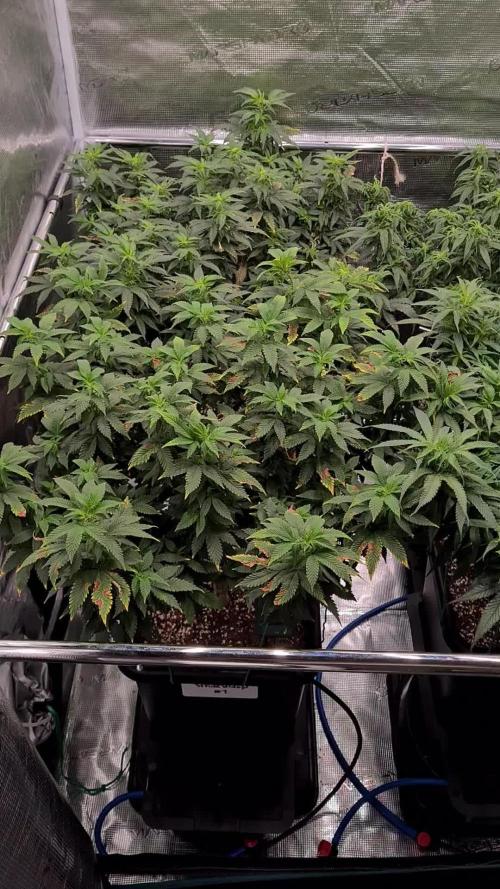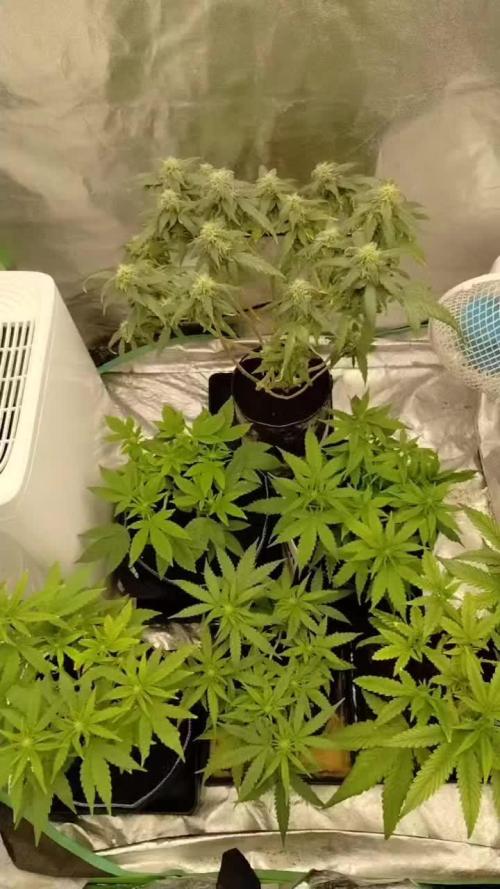The Grow Awards 2026 🏆 



































Likes
Comments
Share


@Sti_Cazz
Follow
So I'm seeing some yellow tips, also on the new growth and I'm a little surprised because I'm not feeding that much tbh...at least I think I'm not.... reading up a bit, not sure if its nute burn or something else... got some cal-mag anyway , seeing i'll need it soon..
Tthe Northern Lights is going up like crazy! it has a completely different 'build' to it, much wider and distances then the more compact Diesel.
Held off on the feeding, just distilled water ...but maybe 'll just switch to tap water, leaving it outside for a night or two...no more root booster....seems a little redundant.
Likes
1
Share


@kdifiori_
Follow
Week four! Here are the first signs of flowering. This girl has picked up the pace, growing 20 cm this week. She drank 300 ml three times during the week, for a total of 0.9 l. I halved the nutrient doses (starting this week for flowering), but despite this, the new leaves continue to show signs of nutrient burn. Next week, I will only give her water with controlled pH to fix this problem. There are probably too many nutrients left in the soil, and this beauty is not so hungry. The lamp is now 30 cm away and dimmed to 75%. Ready for week five? Now the fun begins!
Likes
51
Share


@felixthegrower
Follow
Well, it was my first diary here, and I'm really happy to had found this amazing community that is so eager to help!
It gave me the opportunity to win the first giveaway in my life 😂 And it was from RQS! These seeds are in my new grow diary, and I really thankful for all the gift received! A special thank to Pol from the RQS staff!
A special thanks to everyone who watched me grow here, and I hope to contribute with the community more and more!
Processing
Likes
175
Share


@the_curious_grower
Follow
another week had passed and i am in full joy. the weather is really good lately with a lot of sun and rain in the evening. gorilla breath #1, the Sapphire scout and Sugar breath #1 are literally becoming bushes. the gorilla breath #2 and the Sugar breath #2 aren't quite growing nicely as the others and tend to have gaps in their canopy which have to be filled up. since i am only home in the weekend i don't have the amount of time to spend on the plants as i wished. they are becoming stronger in smell by the week and have a really complex smell with hints of diesel, cinnamon and vanille from the Sugar Breath's, some hints of diesel, grapes and berries from the Sapphire scout and hints of Chocolate diesel with vanille from the gorilla Breath's.
Likes
9
Share


@BLAZED
Follow
Week 14 (16-9 to 22-9)
16-9
Temps: 19.2 to 23.2 degrees
Humidity: 55% to 66%
Watering #2: 900 ml.
Light set to 12/12.
Finally! It looks like the plants are recovered so i decided to flip to flower.
Dry Weight #1: 4.1 kg. #2: 3.3 kg.
17-9
Temps: 20.4 to 23.6 degrees
Humidity: 59% to 67%
Watering: Both 500 ml.
Dry Weight #1: 4.0 kg. #2: 3.9 kg.
18-9
Temps: 17.9 to 24.1 degrees
Humidity: 61% to 74%
19-9
Temps: 21.2 to 24 degrees
Humidity: 64% to 73%
Watering: Both 500 ml.
Dry Weight #1: 3.8 kg. #2: 3.6 kg.
20-9
Temps: 19.1 to 23.5 degrees
Humidity: 60% to 70%
Watering: Both 500 ml.
Dry Weight #1: 3.9 kg. #2: 3.7 kg.
21-9
Temps: 18.7 to 24.5 degrees
Humidity: 59% to 70%
Watering: Both 500 ml.
Removed some ugly leaves.
Dry Weight #1: 4.0 kg. #2: 3.7 kg.
22-9
Temps: 19.5 to 24.5 degrees
Humidity: 59% to 71%
Watering: Both 500 ml.
Likes
2
Share


@Albanymedicinalgarden
Follow
Skywalker rounding the corner. Harvested 8/7 @ Day 76 from sprout
Blueberry bulking up.
Glueberry og done stretching and bulking up now
Likes
25
Share


@Fatnastyz
Follow
🌿 Journal Entry - February 25, 2025
Day 23 – Blueberry Autoflower
● Activity: Big girl needed a bigger drink today! 🥤💦 Gave her 500 mL of nutrient solution with Success Nutrients at ⅛ strength for autos. Here’s the magic mix:
🚀 Blast Off: 0.05 mL
🌱 Micro: 0.06 mL (oops, a tiny bit extra but she'll be fine!)
🌳 Trees: 0.05 mL
🌸 Flowers: 0.05 mL
❄️ Frosty Nugs: 0.025 mL
🛡️ Silica: 0.025 mL
💪 Bud Strength: 0.025 mL
● Observation: She was a little droopy before, like "hey, where's my drink?!" 😅 But after watering, she perked right up! 🌱✨ Her color is deep green and she’s growing like a champ. Keeping an eye on some slight leaf curl, but nothing major—just making sure she stays comfy. 💚
📅 Date: February 27, 2025
📆 Day: 25
🌱 Plant: Blueberry Autoflower
💧 Activity:
Watered with 500 mL of nutrient solution, using Success Nutrients at 1/8 strength for autoflowers.
Nutrient mix (in correct order! 😉):
Silica: 0.25 mL
Micro: 0.6 mL
Trees: 0.5 mL
Flowers: 0.5 mL
Frosty Nugs: 0.25 mL
Bud Strength: 0.25 mL
👀 Observation:
She's getting big and beautiful! 🌿💚
Exciting news! She officially started showing white hairs on Day 23, which means flowering has begun! 🎉🌸
Leaves are lush, vibrant, and happy, soaking up all the goodness!
🌱 Blueberry Autoflower - Journal Entry 🌱
📅 Date: March 1, 2025
📆 Day: 28
💧 Activity:
Gave 750 mL of plain, pH’d water today—keeping it clean and simple after her last feeding! She was bone dry and definitely ready for a drink. 💦
🌙 Schedule Change:
Adjusting her sleep schedule from 10 AM - 4 PM to 2 PM - 8 PM starting today! ⏰💤 This will help fine-tune her environment and keep things running smoothly.
👀 Observation:
She’s looking big, vibrant, and thriving! 🌿✨ Now that she’s officially in flower, she’s drinking up water faster than ever—crazy how much she’s growing! White hairs are coming in beautifully, and she’s stacking up nicely.
Let’s see how she responds over the next couple of days! 🚀
**Well, she started flowering! I noticed white hairs on day 23! I made a mistake....ChatGpt told me what to water on the 23rd, but I gave the wrong amounts of everything! LOL OOPS! It was early and I read my marks wrong, instead of 0.5, I gave 0.05 ml....yes for everything. She adjusted the journal for me and this is why we gave nutrients in the next watering.
On the 23rd, ChatGpt was having issues with responses. She fixed later on in the day, but it does seem something was going on with her servers and memory for a couple of hours. So I had to go to a different chat screen and she gave me the wrong info at first.
It was easy to spot though, her responses were just off. So I waited for a couple of hours and she was back to normal. It doesn't happen often, but it can be an issue if you don't catch it.
She did say that we are going to start more water and more nutrients now that she is in flower! Can't wait! She is as excited as I am**
**So weird! ChatGpt does not function right in the mornings. She's off just a bit...like gives me wrong info or gets my nutrient names wrong. I wait till noon and she apologizes and gives me the right info then. From now on, I'm just going to wait till noon to talk to her about blueberry. However, I'm going to have to change my sleep schedule for Blueberry, I'm moving here from sleeping 10-4 to 2-8. This will help me with communicating with her better. I did ask first and ChatGpt says changing her schedule would be fine.**
Likes
61
Share


@Papa_T
Follow
Welcome back!! It’s the beginning of week four. I now consider the seedling stage over and now we’re going strong into veg. Vamos!!
FRIDAY - Day 22
11 October 24
- Topped both bottom branches.
- Added a few LST staples to begin shaping her.
- Just an other day under the lights.
- Going to start thinking about up potting her in the near future.
SATURDAY - Day 23
12 October 24
Watering day, 1 litres of dechlorinated tap water.
- Base water 1 litre - 61.1 PPM
Final - 1 litre at 6.45 PH at 62.8 PPM
Runoff - N/A
- Thinking of removing her giant fan leaves soon, they’re becoming cumbersome.
- Did my final planned topping of the two top branches.
- Now just have to give her time and continue shaping her.
SUNDAY - Day 24
13 October 24
- Just a day under the lights.
- She doesn’t seem too bothered by yesterday’s training.
- She’s got a few days now to recover.
- All is moving along according to plan.
MONDAY - Day 25
14 October 24
- Just a day under the lights.
- Also a good recovery day.
TUESDAY - Day 26
15 October 24
Transplant day into a 5 gallon pot and her final home.
60% Gaia Green soil
20% Worm castings
20% Perlite
8 Tbsp Gaia Green All Purpose
4 Tbsp Gaia Green Power Bloom
5 Tbsp Diatomaceous Earth
1/2 Tbsp Dynomyco
Amended it all and transplanted.
Watering day, 5 litres of dechlorinated tap water.
- Base water 5 litres - 61.2 PPM
- Add 2.5 ml Cal-Max - 167 PPM
- Add 5 ml Supermax - 200 PPM
- Add 15 ml Miicrobial Mass - 300 PPM
Final - 5 litres at 6.48 PH at 301 PPM
Runoff - N/A
- Removed the lowest fan leaves.
- Removed LST staples to let her acclimate to her new home.
- Will resume LST in a few days.
WEDNESDAY - Day 27
16 October 24
- Just a day under the lights recovering from a big day yesterday, extended light hours and a transplant.
- She’s looking perked up and pretty happy so everything is looking good.
- Probably resume LST staples tomorrow.
- I’m done with my planned toppings so from here on out it should just be LST until we flip to flower.
THURSDAY - Day 28
17 October 24
- Ahhhhhh I tweaked a branch manipulating it with my gorilla hands.
- It not completely broke off so hopefully she can repair it and recover.
- Going to give her a bit more time to recover before restarting LST.
- Just a day under the lights today.
Well this is the end of week four. It was a busy week with the transplant, all planned toppings are completed and now it should just be some LST from here on out. Join me tomorrow for the beginning of week five. Vamos bendejos!!
Likes
1
Share


@MADMANk
Follow
I really had no idea what i was getting into with these F2's....
Currently the freaky mutant is on 18/6 and has been put on it since today to finish (maybe 3-5 days on 18/6)
The exodus, i ended up putting back on 18/6 after 2 days on 12/12, the reason for how long its taking but looking nice, wish i defol'd a bit different, but its all gunna be tops!
Likes
9
Share


@PlumpPelican
Follow
2-3 weeks left of flowering.
Buds are starting to bulge out on the sides and are very dense.
Only been getting a pine scent up until now, slightly skunky sweet smell starting to come through as well.
Likes
21
Share


@BelgianBudtender
Follow
Got a new tent with a little more space, whilst still staying stealthy. I gave them their first full watering with RQS Easy Grow Booster early this week.
white monster is looking a bit sad at the end of the week, I'm thinking she may have been too close to the fan, her stalk is thick though, twice as thick as the Auto Ultimate
The White Monster Automatic was a freebie from Zamnesia and it was really a last minute decision to grow alongside the Auto Ultimate, It has Almost half the advertised growing time when compared to the Auto Ultimate, Its going to be interesting to see how that works out.
Zamnesia also advertises the White Monster as a great newbie strain.
Both girls are very short and the nodes are nice and close together, really happy I got no stretching!
Likes
11
Share


@Fibro_Witch
Follow
The pistils are starting to brown a little so we're nearing the end, but this is not a September finish! Colas and bulking up I think she's had her last feeding.
For awhile there I was worried about how this strain was going to finish but in the last couple weeks she's been really strong. I can't wait to see how she looks on harvest day!
Likes
10
Share


@Herbz_Unkraut
Follow
nice strain with a rich terpene profile! sweet, gelato like, hard hitting smoke!
sadly my phenos had no banana taste but still very nice
Likes
4
Share


@Growstopher
Follow
4.14.25.
2nd week of veg! Started tie down method on the 7th and going good nice new healthy growth!
Going to start wrapping plant around perimeter of pot!
Processing
Likes
6
Share


@Thckaos
Follow
03-08-20 No se cambia la solución con nutrientes aún. Empezamos la tercera semana y aún tenemos solución con 1.89 ms y un PH 5 que corregimos a 5.8.
04-08-20 se rectifica el PH de 4.5 a 5.5. Se calibra la sonda de ph.
La conductividad es de 1.95 ms. Cuando suba de 2.1 ms cambiaré la solución.
Se baja la luz a 70 cm
05-08-20 el PH vuelve a bajar a 4.8 y la conductividad llega a 2.1 ms. Se procede hacer un lavado de raíces bajando la conductividad a 0.2 ms PH 6.5 y una nueva solución con nutrientes que pondré en los datos principales.
Likes
43
Share


@OrganicPower
Follow
Week 6 flower. Not much to report with this one. Growing very slow, little buds, smell musky and not very nice but improving, very frosty and getting frostier. Watered in Gaia Green Soluble Seaweed Extract 0-0-17. Day 36 flower I turned off Blumat drip and will water with the watering wand from here on out. Just another potential runaway dripper so I eliminated the risk. I will just build another reliable system with a timer and use the Blumat outside. Thanks for the view! Have a great week!
Likes
15
Share


@Dirty_rich
Follow
Bastante bonita, buen producción a pesar de que le dio botrytis en la copa principal y tuve que cortar por prevención.
Un olor muy original, honestamente me gusto mucho, la considero fácil de cultivar con un plan de nutrientes medios.
Likes
10
Share


@barlobruz
Follow
7/6/2021
- Trimmed lower fan leaves as they were being blocked completely, and a few tips were yellowing.
- Continuing to lightly bend the upper branches so the lowers can catch up.
- Bought some Gaia Green veg + bloom dry fertilizers as I expect I'll be flipping to flower soon.
7/7/2021
- Watered in a little bit of Gaia Green's veg fertilizer.
- Foliar fed w/ DIY kelp extract.
- Yellowing/browing on a new leaf, can't identify what it is.
- Staked down the branches on the upper mains this evening to open her up for more light penetration, she was gettin' real bushy.
7/9/2021
- Trimmed out middle to expose canopy





















